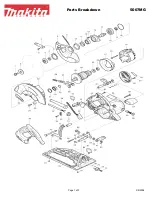
GB
- 54 -
c) Keep children and other people away from the power tool
while you are using it.
If you are distracted you may lose con-
trol of the power tool.
2. Electrical safety
a) The plug on the power tool must
fi
t into the socket. The so-
cket must not be modi
fi
ed in any way. Do not use adapter
plugs together with power tools with a protective earth.
Unmodi
fi
ed plugs and matching sockets will reduce the risk of an
electric shock.
b) Avoid body contact with earthed surfaces such as pipes,
heating systems, stoves and refrigerators.
There is an incre-
ased risk of su
ff
ering an electric shock if your body is earthed.
c) Keep the power tool out of the rain and away from moistu-
re.
The ingress of water into an electric power tool increases the
risk of an electric shock.
d) Do not use the power cable for a purpose for which it is not
designed, for example to carry the power tool, hang it up
or to pull the plug out of the socket. Keep the power cable
away from heat, oil, sharp edges and moving parts.
Power
cables that are damaged or tangled increase the risk of an elec-
tric shock.
e) If you use an electric power tool outdoors, use only exten-
sion cables that are suitable for outdoor use.
The use of an
extension cable which is suitable for outdoor use reduces the
risk of an electric shock.
f) If you cannot avoid using the power tool in a damp loca-
tion, use a residual current device (RCD) circuit breaker.
The use of a residual current device (RCD) circuit breaker will
reduce the risk of su
ff
ering an electric shock.
3. Safety of persons
a) Be careful, watch what you are doing and be sensible
and responsible when using an electric power tool. Never
use the power tool if you are tired or under the in
fl
uence
Anl_TC_TS_2000_U_SPK9.indb 54
Anl_TC_TS_2000_U_SPK9.indb 54
28.04.2020 14:40:08
28.04.2020 14:40:08
















































